Serving 300 students in grades Prekindergarten-6, Trotter Elementary School ranks in the bottom 50% of all schools in Massachusetts for overall test scores (math proficiency is bottom 50%, and reading proficiency is bottom 50%).
The percentage of students achieving proficiency in math is 6-9% (which is lower than the Massachusetts state average of 41%). The percentage of students achieving proficiency in reading/language arts is 15-19% (which is lower than the Massachusetts state average of 44%).
The student:teacher ratio of 9:1 is lower than the Massachusetts state level of 12:1.
Minority enrollment is 96% of the student body (majority Black), which is higher than the Massachusetts state average of 47% (majority Hispanic and Black).
Quick Stats (2025)
- Grades: Prekindergarten-6
- Enrollment: 300 students
- Student:Teacher Ratio: 9:1
- Minority Enrollment: 96%
- Overall Testing Rank: Bottom 50% in MA
- Math Proficiency: 6-9% (Btm 50%)
- Reading Proficiency: 15-19% (Btm 50%)
- Science Proficiency: ≤10% (Btm 50%)
- Source: National Center for Education Statistics (NCES), MA Dept. of Education
Top Rankings
Trotter Elementary School ranks among the top 20% of public schools in Massachusetts for:
Category
Attribute
Percent Eligible For Free Lunch
Student Attention
School Overview
Trotter Elementary School's student population of 300 students has declined by 40% over five school years.
The teacher population of 35 teachers has stayed relatively flat over five school years.
Grades Offered
Grades Prekindergarten-6
(offers virtual instruction)
(offers virtual instruction)
Total Students
300 students
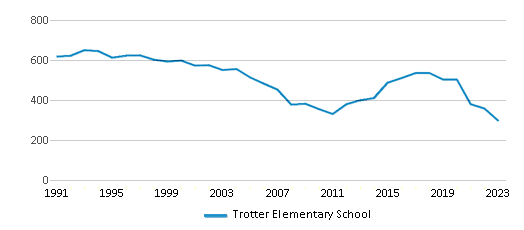
Gender %
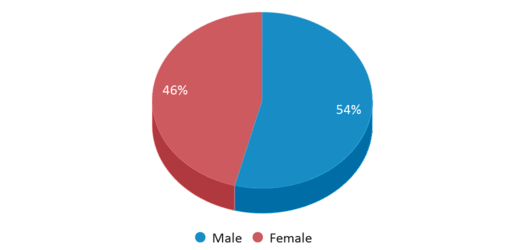
Total Classroom Teachers
35 teachers
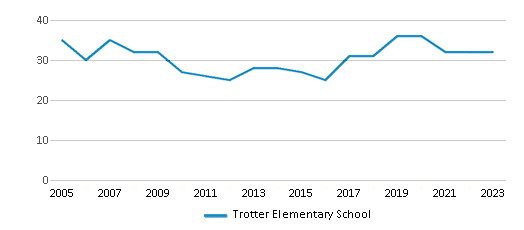
Students by Grade
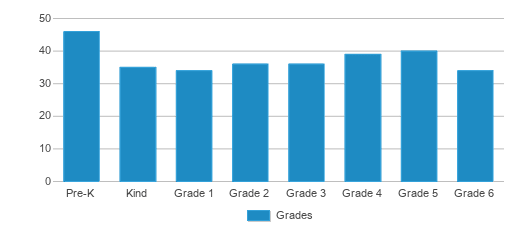
School Rankings
Trotter Elementary School ranks within the bottom 50% of all 1,631 schools in Massachusetts (based off of combined math and reading proficiency testing data).
The diversity score of Trotter Elementary School is 0.60, which is less than the diversity score at state average of 0.65. The school's diversity has stayed relatively flat over five school years.
Overall Testing Rank
#1552 out of 1631 schools
(Bottom 50%)
(Bottom 50%)
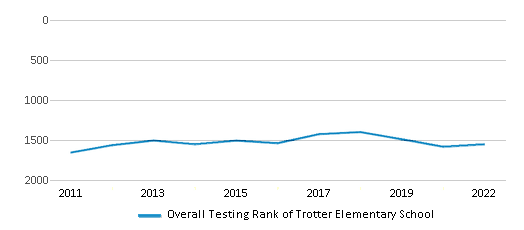
Math Test Scores (% Proficient)
6-9%
41%
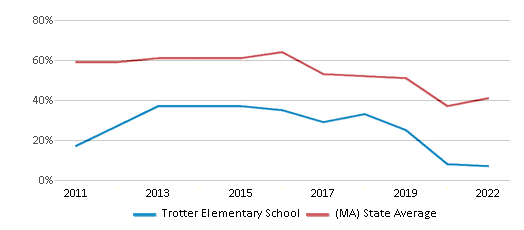
Reading/Language Arts Test Scores (% Proficient)
15-19%
44%
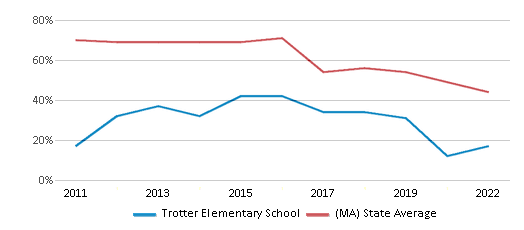
Science Test Scores (% Proficient)
≤10%
44%
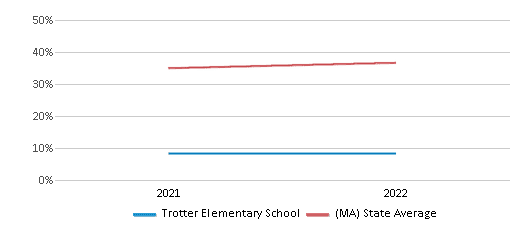
Student : Teacher Ratio
9:1
12:1
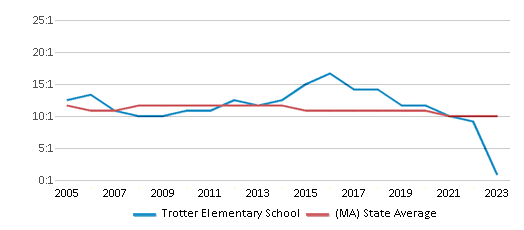
American Indian
n/a
n/a
Asian
2%
7%

Hispanic
35%
25%
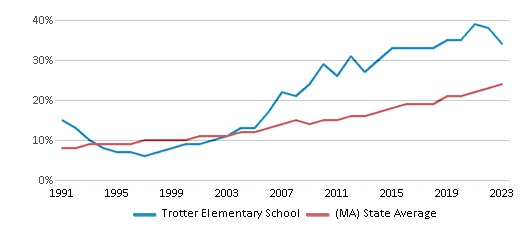
Black
53%
10%
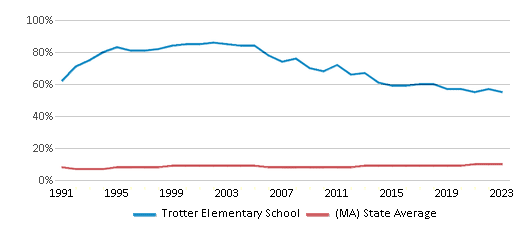
White
4%
53%
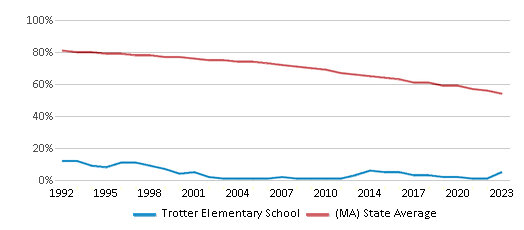
Hawaiian
2%
n/a
Two or more races
4%
5%
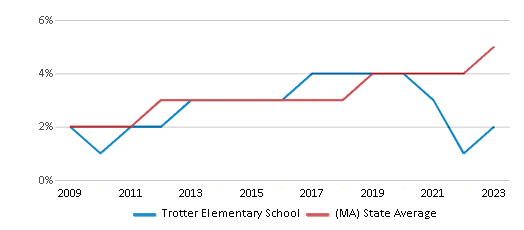
All Ethnic Groups
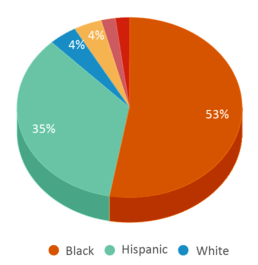
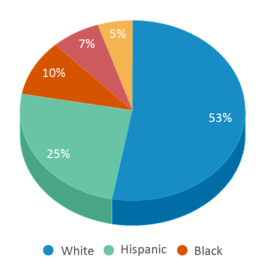
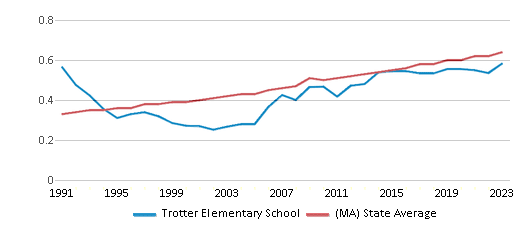
Participates in the National School Lunch Program (NSLP)
Yes
Eligible for Free Lunch
100%
35%
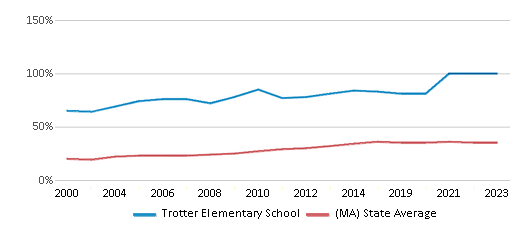
Eligible for Reduced Lunch (12-13)
2%
5%
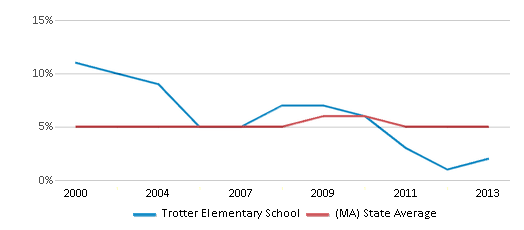
School Statewide Testing
School District Name
Source: National Center for Education Statistics (NCES), MA Dept. of Education
Profile last updated: 02/09/2025
Frequently Asked Questions
What is Trotter Elementary School's ranking?
Trotter Elementary School is ranked #1552 out of 1,631 schools, which ranks it among the bottom 50% of public schools in Massachusetts.
What schools are Trotter Elementary School often compared to?
Trotter Elementary Schoolis often viewed alongside schools like Tobin K-8 School, Higginson-lewis K-8 School by visitors of our site.
What percent of students have achieved state testing proficiency in math and reading?
6-9% of students have achieved math proficiency (compared to the 41% MA state average), while 15-19% of students have achieved reading proficiency (compared to the 44% MA state average).
How many students attend Trotter Elementary School?
300 students attend Trotter Elementary School.
What is the racial composition of the student body?
53% of Trotter Elementary School students are Black, 35% of students are Hispanic, 4% of students are White, 4% of students are Two or more races, 2% of students are Asian, and 2% of students are Hawaiian.
What is the student:teacher ratio of Trotter Elementary School?
Trotter Elementary School has a student ration of 9:1, which is lower than the Massachusetts state average of 12:1.
What grades does Trotter Elementary School offer ?
Trotter Elementary School offers enrollment in grades Prekindergarten-6 (offers virtual instruction).
What school district is Trotter Elementary School part of?
Trotter Elementary School is part of Boston School District.
In what neighborhood is Trotter Elementary School located?
Trotter Elementary School is located in the Roxbury neighborhood of Dorchester, MA. There are 2 other public schools located in Roxbury.
School Reviews
2 10/10/2014
The School is unorganized and unprofessional. The staff does not care about the students. Those children can not strive at the Trotter Elementary School in Dorchester. I strongly believe if you want your children to succeed and reach their highest potential you must get your child out of that school immediately, Do not hesitate. The MCAS Scores and how the school improved in one year, after the principal had to make a few changes, as far as letting teachers go. Think about it very carefully. It only took only one year for the school to improve. MCAS scores went up drastically. No the staff changed the answers and help the students to cheat, to save the school so that everyone can continue to receive a pay check. That is why the schools is now they "say is one of the best school". How in one year all the students at the Trotter did so well on the MCAS?
2 10/5/2010
Need after school program of no cost to parents, parents are already struggling as it is. I think this school needs some serious improvements as far as tutors, mentors.
Review Trotter Elementary School. Reviews should be a few sentences in length. Please include any comments on:
- Quality of academic programs, teachers, and facilities
- Availability of music, art, sports and other extracurricular activities
Recent Articles

What Is A Charter School?
Explore the world of charter schools in this comprehensive guide. Learn about their history, how they operate, and the pros and cons of this educational innovation. Discover key facts about charter schools, including admission policies, demographics, and funding, as well as what to look for when considering a charter school for your child.

10 Reasons Why High School Sports Benefit Students
Discover the 10 compelling reasons why high school sports are beneficial for students. This comprehensive article explores how athletics enhance academic performance, foster personal growth, and develop crucial life skills. From improved fitness and time management to leadership development and community representation, learn why participating in high school sports can be a game-changer for students' overall success and well-being.

February 05, 2025
Understanding the U.S. Department of Education: Structure, Impact, and EvolutionWe explore how the Department of Education shapes American education, from its cabinet-level leadership to its impact on millions of students, written for general audiences seeking clarity on this vital institution.









